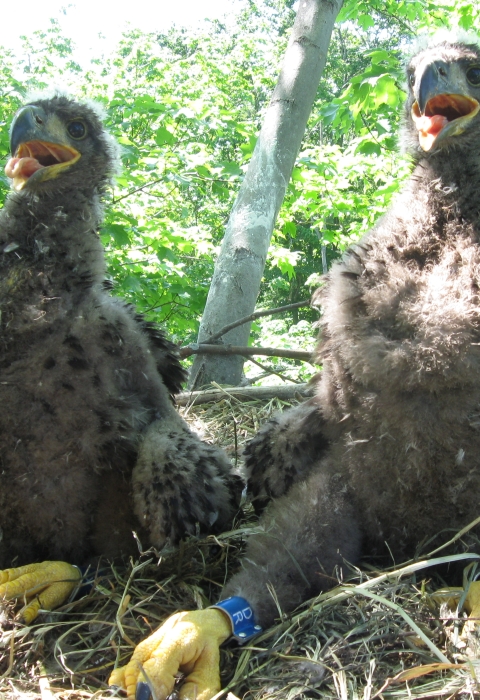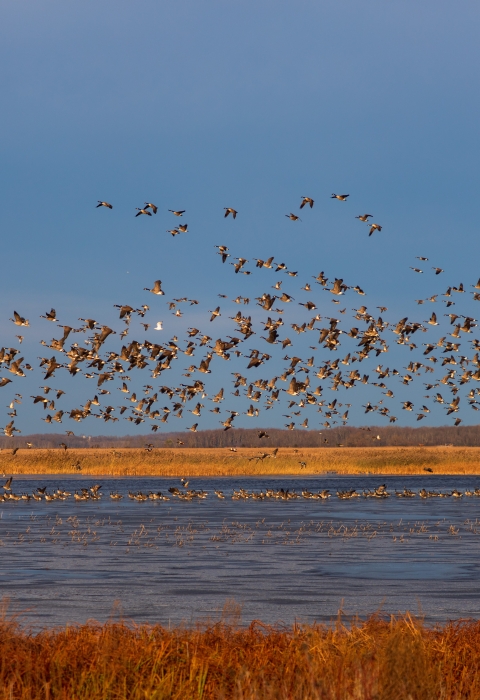What We Do
Wildlife conservation is at the heart of the National Wildlife Refuge System. It drives everything on U.S. Fish and Wildlife Service lands and waters managed within the Refuge System, from the purposes for which a national wildlife refuge national wildlife refuge
A national wildlife refuge is typically a contiguous area of land and water managed by the U.S. Fish and Wildlife Service for the conservation and, where appropriate, restoration of fish, wildlife and plant resources and their habitats for the benefit of present and future generations of Americans.
Learn more about national wildlife refuge is established to the recreational activities offered to the resource management tools used. Using conservation best practices, the Refuge System manages Service lands and waters to help ensure the survival of native wildlife species.
While a visit to Montezuma NWR can transport you deep into nature, it is important to know that much of the refuge is human-made and therefore continuously monitored and managed. Each refuge pool is created using heavy equipment to build dikes that hold water. Each pool also has a water control structure structure
Something temporarily or permanently constructed, built, or placed; and constructed of natural or manufactured parts including, but not limited to, a building, shed, cabin, porch, bridge, walkway, stair steps, sign, landing, platform, dock, rack, fence, telecommunication device, antennae, fish cleaning table, satellite dish/mount, or well head.
Learn more about structure to allow water to be drained as needed for optimum habitat. The Main Pool also has an inlet from Cayuga Lake, so can be filled using gravity-fed lake water. Other pools rely on water being pumped in or on rain to refill. A pool may be drained during spring and summer for one of two reasons: either to let plants regrow and refresh the marsh; or to create feeding habitat for migrating shorebirds.
Grassland and shrubland habitats undergo regular regimes of mowing/clearing in order to hold back natural succession to forest. We also used prescribed fire on some of our grasslands. Currently forest management includes monitoring trees that were planted several years ago, studying the impacts of white-tailed deer on certain forested areas, and monitoring for invasive species invasive species
An invasive species is any plant or animal that has spread or been introduced into a new area where they are, or could, cause harm to the environment, economy, or human, animal, or plant health. Their unwelcome presence can destroy ecosystems and cost millions of dollars.
Learn more about invasive species threats to certain species of trees.
Management and Conservation
Refuges deploy a host of scientifically sound management tools to address biological challenges. These tools span active water management to wilderness character monitoring, all aimed at ensuring a balanced conservation approach to benefit both wildlife and people. At Montezuma NWR our conservation tool box includes:
Planning – Comprehensive Conservation Plan
Habitat Restoration focuses on restoring wetlands within the historic Montezuma marshes, primarily focusing on restoring formerly farmed “mucklands” to emergent marsh habitats.
Climate Resilience
Conservation Easements
Compatibility Determinations
Contaminants Mitigation
Cultural Resources
Education & Outreach
Emergency and Physical Security
Human Dimensions
Invasive Species
Inventory and Monitoring
Land Acquisition
Law Enforcement
Pesticide Management
Recreation Management
Species Research
Water Management
Wildlife Health
Our Services
At this field station we offer the following public services:
Buy Duck Stamps
Habitat Planning & Management
Photo Blinds
Special Use Permit
Special Use Permit-Commercial Photography
Recreation-link to Visit Us
Our Projects and Research
Wetland Restoration/Montezuma Wetlands Complex Partnership
As an establishing member of the Montezuma Wetlands Complex (Complex) partnership, the Montezuma NWR focuses much of its resources on wetland restoration. The Complex partnership includes the Montezuma NWR, New York State Department of Environmental Conservation Northern Montezuma Wildlife Management Area, Friends of the Montezuma Wetlands Complex, Montezuma Audubon Center, Ducks Unlimited, and The Nature Conservancy. Complex partners work together to restore the historic Montezuma marshes—50,000 acres of wetlands that were drained in the early 1900s as a result of canal construction.
While the main purpose of the Complex partnership is to manage the area comprehensively (since the wildlife does not pay any mind to land ownership boarders!) to benefit marsh-dwelling wildlife, we also work together to provide opportunities for you to enjoy nature and get involved. Guided tours and educational programs offer in-person experiences to get to know not only the lands and waters, but also the staff. The Complex’s premiere volunteer program (MARSH! – the Montezuma Alliance for the Restoration of Species and Habitats!) allows you to work side-by-side with staff and other volunteers while you help restore habitats for native species. You also get to go “behind the scenes” of refuge management and enter into areas on the Complex where most visitors are not permitted!
Land Acquisition
Land acquisition has been part of Montezuma’s story since it was established. The refuge, in cooperation with the Montezuma Wetlands Complex, is actively purchasing land from willing sellers in an effort to restore the historic Montezuma marshes. Tax dollars are not used, but rather funds are primarily collected from the sale of Duck Stamps. While migratory bird hunters are required by law to purchase a Duck Stamp each year, we also encourage other refuge visitors to buy one to help support the land restoration efforts that result in other activities like birding and photography!
Water Level Management for Priority Species
The 10,000-acre Montezuma NWR is located in what was historically called the Montezuma Marshes. The water level within these marshes has been lowered by 10 feet for the construction and maintenance of the NY State Canal System, giving rise to the need to create and manage impoundments to provide historic habitat conditions.
We manage water levels within these impoundments to provide habitat for high conservation priority waterbird species including: migrating waterfowl, such as northern pintail; migrating shorebirds, such as greater and lesser yellowlegs; and a variety of nesting marsh birds, such as black terns, American and least bitterns, and pied-billed grebes. Species within these groups require different water levels and habitat conditions so impoundments are managed in a rotation to provide a variety of habitats at any given time.
When you visit the refuge, you are likely to see impounded areas that have been completely drained to mimic a drought and encourage plant growth, units with a lot of mudflats and shallow water for shorebirds, and wetlands with a mix of open water and vegetation for waterfowl and marsh birds.
Law Enforcement
Protecting resources and people on our refuges is the fundamental responsibility of refuge officers. The mission of the Refuge Law Enforcement Program is to support the administration of the National Wildlife Refuge System through the management and protection of natural, historic and cultural resources, property, and people on lands and waters of our national wildlife refuges.
The refuge also works closely with the New York State Department of Environmental Conservation Environmental Enforcement Officers (NYS DEC EEO) to maintain visitor safety and natural resource protection within the Montezuma Wetlands Complex. Dangerous of suspect behavior may be reported by calling NYS DEC EEO Dispatch at 1-877-457-5680. Poaching and violation of other fish and game laws can be reported by calling 1-800-TIPP-DEC.
Refuge Law Enforcement Objectives
Law enforcement is an integral part of managing the National Wildlife Refuge System. Refuge law enforcement officers are responsible for upholding federal laws and regulations that protect natural resources, the public, and employees. These are our objectives:
To protect refuge visitors and employees from disturbance or harm by others
To assist visitors in understanding refuge laws, regulations, and the reasons for them.
To enhance the management and protection of fish and wildlife resources on refuges.
To ensure the legally prescribed, equitable use of fish and wildlife resources on refuges.
To obtain compliance with laws and regulations necessary for the proper administration, management, and protection of the National Wildlife Refuge System
Laws and Regulations
In order to protect the integrity of the refuge, there are certain rules and regulations that must be adhered to when visiting. There are multiple uses of the refuge. They include, but not limited to, activities such as hiking, bird watching, hunting, fishing and photography. Some activities may require permits.
There are many closed areas on the refuge. Please be aware of your location and obey all posted signs. As some areas are not posted, it is the visitors’ responsibility to know where they can and cannot go. You are visiting someone else’s home, so please remember:

